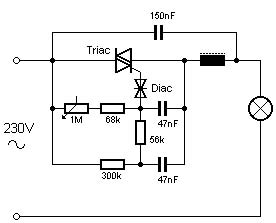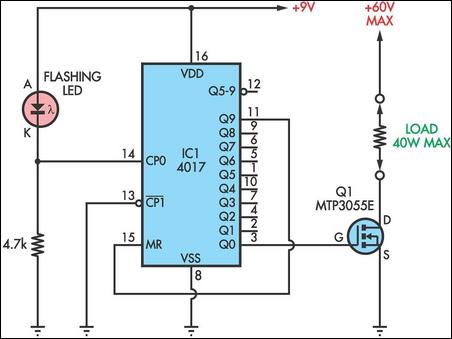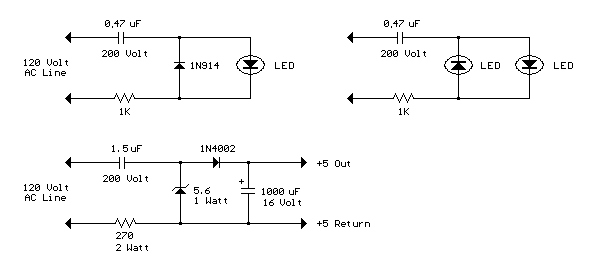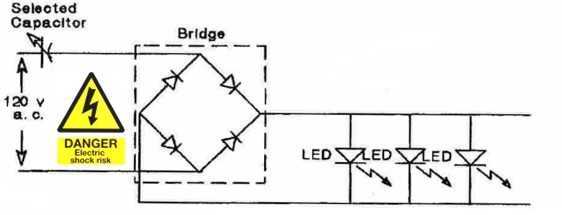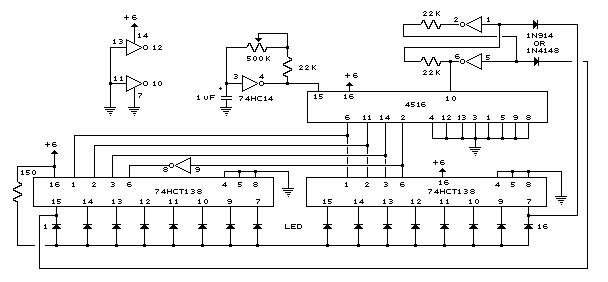
LEDs or Lamps Sequencer
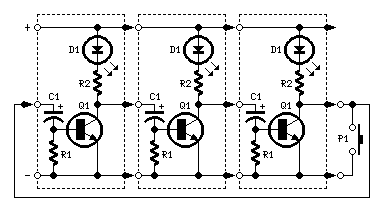
Very simple, versatile modular design. The purpose of this circuit was to create a ring in which LEDs or Lamps illuminate sequentially. Its main feature is a high versatility: you can build a loop containing any number of LEDs or Lamps, as each illuminating device has its own small circuit. The diagrams show three-stage circuits for simplicity: you can add an unlimited number of stages (shown in dashed boxes), provided the last stage output was returned to the first stage input, as shown. No limits to the number of modules used in the ring. More: P1 pushbutton purpose is to allow a sure start of the sequence at power-on but, when a high number of stages is used, it also allows illumination of more than one LED or Lamp at a time, e.g. one device illuminated and three out and so on. After power-on,
The described circuit is a modular LED or lamp sequencer designed for versatility and scalability. The core functionality revolves around a ring configuration where each illuminating device operates within its own small circuit. This modular design allows for the easy addition of any number of stages, enabling a customizable sequence of illumination.
Each stage of the circuit consists of an LED or lamp connected in series with its control circuitry. The control circuitry typically includes a transistor or a similar switching device that is driven by a preceding stage. This arrangement allows for the sequential activation of each LED or lamp, creating a visually appealing effect as they light up one after another.
The circuit incorporates a pushbutton switch, designated as P1, which serves a dual purpose. Primarily, it provides a reliable means to initiate the illumination sequence upon powering on the circuit. Additionally, when multiple stages are employed, P1 can facilitate the simultaneous illumination of more than one LED or lamp, enhancing the flexibility of the design. For example, it is possible to have one device lit while others remain off, allowing for various lighting patterns.
The schematic representation of the circuit typically illustrates three stages for clarity, but it is essential to note that the design is inherently expandable. Dashed boxes in the diagram indicate where additional stages can be incorporated. The last stage's output must be connected back to the first stage's input to maintain the circular flow of the sequence. This feedback loop is crucial for enabling continuous operation without interruption.
In summary, this modular LED or lamp sequencer circuit is characterized by its simplicity, versatility, and scalability, making it suitable for a wide range of applications where sequential lighting effects are desired. The ability to add unlimited stages further enhances its adaptability, allowing users to tailor the circuit to specific requirements.Very simple, versatile modular design. The purpose of this circuit was to create a ring in which LEDs or Lamps illuminate sequentially. Its main feature is a high versatility: you can build a loop containing any number of LEDs or Lamps, as each illuminating device has its own small circuit. The diagrams show three-stage circuits for simplicity: you can add an unlimited number of stages (shown in dashed boxes), provided the last stage output was returned to the first stage input, as shown.
No limits to the number of modules used in the ring.
The described circuit is a modular LED or lamp sequencer designed for versatility and scalability. The core functionality revolves around a ring configuration where each illuminating device operates within its own small circuit. This modular design allows for the easy addition of any number of stages, enabling a customizable sequence of illumination.
Each stage of the circuit consists of an LED or lamp connected in series with its control circuitry. The control circuitry typically includes a transistor or a similar switching device that is driven by a preceding stage. This arrangement allows for the sequential activation of each LED or lamp, creating a visually appealing effect as they light up one after another.
The circuit incorporates a pushbutton switch, designated as P1, which serves a dual purpose. Primarily, it provides a reliable means to initiate the illumination sequence upon powering on the circuit. Additionally, when multiple stages are employed, P1 can facilitate the simultaneous illumination of more than one LED or lamp, enhancing the flexibility of the design. For example, it is possible to have one device lit while others remain off, allowing for various lighting patterns.
The schematic representation of the circuit typically illustrates three stages for clarity, but it is essential to note that the design is inherently expandable. Dashed boxes in the diagram indicate where additional stages can be incorporated. The last stage's output must be connected back to the first stage's input to maintain the circular flow of the sequence. This feedback loop is crucial for enabling continuous operation without interruption.
In summary, this modular LED or lamp sequencer circuit is characterized by its simplicity, versatility, and scalability, making it suitable for a wide range of applications where sequential lighting effects are desired. The ability to add unlimited stages further enhances its adaptability, allowing users to tailor the circuit to specific requirements.Very simple, versatile modular design. The purpose of this circuit was to create a ring in which LEDs or Lamps illuminate sequentially. Its main feature is a high versatility: you can build a loop containing any number of LEDs or Lamps, as each illuminating device has its own small circuit. The diagrams show three-stage circuits for simplicity: you can add an unlimited number of stages (shown in dashed boxes), provided the last stage output was returned to the first stage input, as shown.
No limits to the number of modules used in the ring.
P1 pushbutton purpose is to allow a sure start of the sequence at power-on but, when a high number of stages is used, it also allows illumination of more than one LED or Lamp at a time, e.g. one device illuminated and three out and so on. After power-on,
🔗 External reference